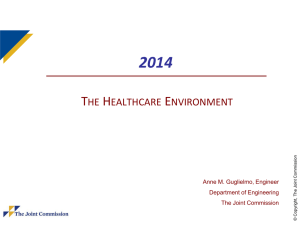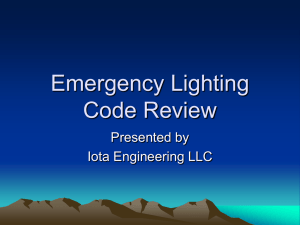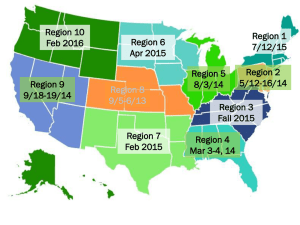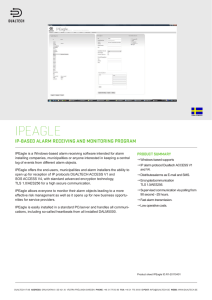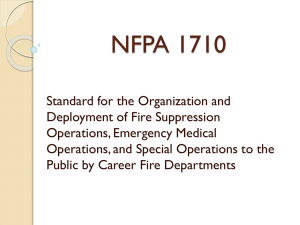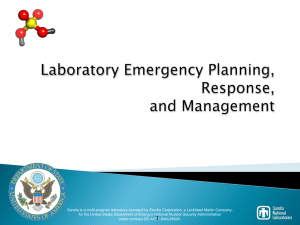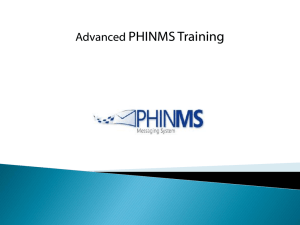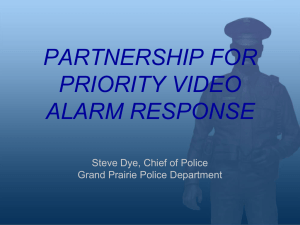2014
advertisement
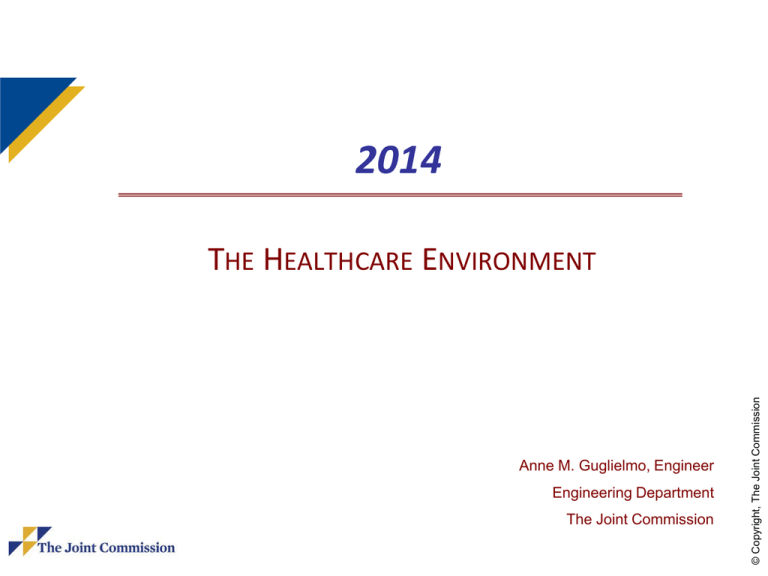
2014 Anne M. Guglielmo, Engineer Engineering Department The Joint Commission © Copyright, The Joint Commission THE HEALTHCARE ENVIRONMENT 2013 Non Compliance RC.01.01.01 LS.02.01.20 IC.02.02.01 61% 51% 42% 55% 54% 47% EC.02.05.01 LS.02.01.10 34% 46% 46% 46% EC.02.03.05 40% 44% LS.02.01.30 LS.02.01.35 39% 34% 43% 38% EC.02.06.01 MM.03.01.01 35% 35% 36% 33% Department of Engineering 2014 - 2 © Copyright, The Joint Commission 2012 Non Compliance Standard/NPSG 2013 Non Compliance EC.02.02.01 PC.01.03.01 MM.04.01.01 30% 25% 26% 33% 26% 24% EC.02.05.07 EC.02.05.09 22% 23% 23% 22% HR.01.02.05 PC.01.02.03 EC.02.03.01 16% 25% 19% 22% 21% 19% MS.01.01.01 PC.03.01.03 21% 19% 18% 18% Department of Engineering 2014 - 3 © Copyright, The Joint Commission 2012 Non Compliance Standard/NPSG ASHRAE voted in July 2013 to move endoscopy procedure rooms from positive to N/A. FGI is planning on releasing this in the November publication of the 2014 FGI Guidelines. Therefore, if an organization had made a documented decision based on risk assessment to no longer monitor endoscopy procedure rooms as per the 2013 ASHRAE action, we would accept this. If the organization has not made a documented decision, the room should be evaluated as per the below table and construction date. No change to bronchoscopy procedure rooms. Department of Engineering 2014 - 4 © Copyright, The Joint Commission NOTE: THIS JUST IN GUIDELINES VENTILATION TABLE: ENDOSCOPY & BRONCHOSCOPY ENDOSCOPY PRESSURE PROCEDURE DIRECT EXHAUST 2014 (pending) N/A N/A PROCESSING (CLEANING) DIRECT EXHAUST PRESSURE YES Negative (-) PROCEDURE DIRECT EXHAUST PRESSURE YES Negative (-) 2010 Positive (+) N/A Negative (-) YES Negative (-) YES 2006 Neutral N/A Negative (-) YES Negative (-) YES 2001 Negative (-) N/A N/A N/A Negative (-) YES 1996/1997 N/A N/A N/A N/A Negative (-) YES 1992/1993 N/A N/A N/A N/A N/A N/A 1987 N/A N/A N/A N/A N/A N/A 1979 N/A N/A N/A N/A N/A N/A Department of Engineering 2014 - 5 © Copyright, The Joint Commission Edition BRONCHOSCOPY THE FOLLOWING ARE AVAILABLE WITH CERTAIN PROVISIONS. THESE ARE BASED ON CMS S&C 13-58-LSC © Copyright, The Joint Commission 2012 LIFE SAFETY CODE UPDATE BACKGROUND The Joint Commission provided CMS with a list of items, based on later editions of the Life Safety Code, that would immediately have a positive impact on all healthcare recommendation in the form of a State & Certification letter (S&C 13-58-LSC) The action is a series of Categorical Waivers Department of Engineering 2014 - 7 © Copyright, The Joint Commission CMS acted on the Joint Commission If the organization decides to adopt these categorical waivers they must 1. Ensure full compliance with the appropriate code reference 2. Document the decision to adopt the categorical waiver For Life Safety Code items annotate the “Additional Comments” Section in the Statement of Conditions™ Basic Building Information (BBI) For Environment of Care items document by Minutes in discussion at the Environment of Care Committee (or equivalent) 3. Declare the decision at the beginning of any survey Department of Engineering 2014 - 8 © Copyright, The Joint Commission PROCESS RH 20 – 60% RANGE ASC to align with the 2010 FGI Guidelines for Design & Construction of Health Care Facilities use of ASHRAE 1702008 Reduced the relative humidity (RH) in certain areas to a range of 20 – 60% This 2013 CMS action matched the Joint Commission’s 1/2011 adoption of the 2010 Guidelines and the 20 – 60% RH range provided The S&C had two criteria 1. Document the decision 2. Declare at the beginning of a survey the decision Department of Engineering 2014 - 9 © Copyright, The Joint Commission CMS first issued a Categorical Waiver in S&C 13-25-LSC & MEANS OF EGRESS 18/19.2.1 18/19.2.1 which allow, under certain Department of Engineering 2014 - 10 © Copyright, The Joint Commission circumstances, existing openings to exit enclosures to mechanical room spaces as provided at section 7.1.3.2 Exits and more specifically the requirements at 7.1.3.2(9)(c) EXISTING OPENINGS TO MECHANICAL SPACES Section 7.1.3.2.1(9)(c): (c) Existing openings to mechanical equipment spaces protected by approved existing fire protection–rated door assemblies shall be permitted, provided that the following criteria are met: The space is used solely for non-fuel-fired mechanical equipment. The space contains no storage of combustible materials. The building is protected throughout by an approved, supervised automatic sprinkler system in accordance with Section 9.7. Department of Engineering 2014 - 11 © Copyright, The Joint Commission 18/19.2.1 requires compliance with Chapter 7, including 18/19.2.5.7 SUITES circumstances, one of the exit access doors in a sleeping suite be permitted to be directly to an exit stair, exit passageway or exit to the exterior; 18/19.2.5.7.3.1(B) which allow, under certain circumstances, one of the exit access doors in a non-sleeping suite be permitted to be directly to an exit stair, exit passageway or exit to the exterior; 18/19.2.5.7.1.2 which allow, under certain circumstances, suites to be separated by corridor wall requirements; Department of Engineering 2014 - 12 © Copyright, The Joint Commission 18/19.2.5.7.2.1(B) which allow, under certain MEANS OF EGRESS 18/19.2.2.2 certain circumstances, more than one delayed egress in the egress path 18/19.2.2.2.6 which allow, under certain circumstances, remote control of locks for the rapid removal of occupants Department of Engineering 2014 - 13 © Copyright, The Joint Commission 18/19.2.2.2.4 which allow, under MEANS OF EGRESS 18/19.2.2.2 circumstances, door locking arrangements where clinical needs of patients require specialized security measures or where patients pose a security threat 18/19.2.2.2.5.2 which allow, under certain circumstances, door locking arrangements based on the patient special needs requiring specialized security measures for their safety Department of Engineering 2014 - 14 © Copyright, The Joint Commission 18/19.2.2.2.5.1 which allow, under certain SUITES allow, under certain circumstances, patient sleeping suites up to 10,000square feet 18/19.2.5.7.2.2(C) which allow, under certain circumstances, one of the two required exits in a sleeping suite to exit into another suite 18/19.2.5.7.3.2(C) which allow, under certain circumstances, one of the two required exits in a non-sleeping suite to exit into another suite; Department of Engineering 2014 - 15 © Copyright, The Joint Commission 18/19.2.5.7.2.3(B) and 18/19.2.5.7.2.3(C) which 96 GALLON CONTAINERS circumstances container used solely for recycling clean waste or patient records awaiting destruction up to 96 gallons not be stored in a room identified as hazardous storage. Soiled linen or trash receptacles shall not exceed 32 gallons and comply with 18/19.7.5.7.1 Department of Engineering 2014 - 16 © Copyright, The Joint Commission 18/19.7.5.1 which allow, under certain MODIFIED S&C 12-21-LSC CATEGORICAL WAIVER NOW APPLIES: WHEELED EQUIPMENT EXPANDED specifically the requirements at 18/19.2.3.4 which allow, under certain circumstances, projections into the means of egress corridor width for wheeled equipment including lifts and transport equipment Provided 5ft clear corridor width is maintained Fire plan addresses management of storage Accommodates current “equipment in use” criteria Department of Engineering 2014 - 17 © Copyright, The Joint Commission 18/19.2.3 Capacity of Means of Egress and more MODIFIED S&C 12-21-LSC CATEGORICAL WAIVER NOW APPLIES: FIXED SEATING ALLOWED specifically the requirements at 18/19.2.3.4 which allow, under certain circumstances, projections into the means of egress corridor width for fixed furniture Provided provided 6ft clear width < 50sqft with 10’ between groupings Groupings must be on same side of the egress corridor Department of Engineering 2014 - 18 © Copyright, The Joint Commission 18/19.2.3 Capacity of Means of Egress and more MODIFIED S&C 12-21-LSC CATEGORICAL WAIVER NOW APPLIES: CORRIDOR COOKING ALLOWED requirements at 18/19.3.2.5.2 - 18/19.3.2.5.5 which allow certain types of alternative kitchen cooking arrangements One cooking area may be open to the egress corridor per smoke compartment Any additional cooking areas must be in protected room similar to hazardous areas Provisions: No deep fat fryers Safety equipment to de-activate fuel supply Grease baffles installed No solid fuel (i.e. charcoal) Department of Engineering 2014 - 19 © Copyright, The Joint Commission 18/19.3.2.5 Cooking Facilities, more specifically the MODIFIED S&C 12-21-LSC CATEGORICAL WAIVER NOW APPLIES: FIREPLACES PLACEMENT MODIFIED Conditioning more specifically the requirements at 18/19.5.2.3(2), (3) and (4) which allow the installation of direct vent gas fireplaces in smoke compartments containing patient sleeping rooms and the installation of solid fuel burning fireplaces in areas other than patient sleeping areas Department of Engineering 2014 - 20 © Copyright, The Joint Commission 18/19.5.2 Heating, Ventilating, and Air MODIFIED S&C 12-21-LSC CATEGORICAL WAIVER NOW APPLIES: COMBUSTIBLE DECORATIONS ADJUSTED including sections 18/19.7.5.6 which allow the installation of combustible decorations on walls, doors and ceilings. 1. On non-fire rated doors and do not interfere with latching or area limits at 18/19.7.5.6(b), (c), (d) 2. < 20% of wall, ceiling and door, inside a room or space of a smoke compartment that is not protected throughout with approved automatic sprinkler system Department of Engineering 2014 - 21 © Copyright, The Joint Commission 18/19.7.5 Furnishings, Mattresses, and Decorations MODIFIED S&C 12-21-LSC CATEGORICAL WAIVER NOW APPLIES: COMBUSTIBLE DECORATIONS ADJUSTED 3. < 30% of wall, ceiling and door inside a room or space of a smoke compartment that is protected throughout by an approved supervised automatic sprinkler system 4. < 50% of wall, ceiling and door, inside a patient sleeping room with capacity of < 4 persons in a smoke compartment that is protected throughout with approved, supervised automatic sprinkler system Department of Engineering 2014 - 22 © Copyright, The Joint Commission Continued: CENTRALIZED COMPUTER SYSTEM FOR MEDICAL GAS MASTER ALARM edition of the Health Care Facilities Code, and more specifically 5.1.9.2.2 which allows a centralized computer system to be permitted to be substituted for one of the medical gas master alarms required at 5.1.9.2.1 if the computer system complies with 5.1.9.4. Department of Engineering 2014 - 23 © Copyright, The Joint Commission 101-2012 Section 2.2 refers to the 2012 ANNUAL LOAD BANK TEST REDUCED 25% SAVINGS the requirements at 8/19.2.9.1 which refers to 7.9, which refers to NFPA 110-2010 which includes requirements for annual load bank tests as follows: 30 minutes at 50% of nameplate, and 60 minutes at 75% of nameplate see NFPA 110-2010 8.4.2.3 Cost savings of 25% based on reduction of two hour test by 25% Department of Engineering 2014 - 24 © Copyright, The Joint Commission 18/19.2.9 Emergency Lighting, more specifically WEEKLY CHURN NOW MONTHLY: ELECTRIC MOTOR DRIVEN FIRE PUMP Requirements, and more specifically the requirements at 9.7.5 Maintenance and Testing which refers to NFPA 25-2011. This edition of NFPA 25, the Standard for the Inspection, Testing & Maintaining of Water-Based Fire Protection Systems section 8.3.1.2.which requires the electric motor driven fire pump exercise to be monthly; Cost savings of reducing a weekly test to monthly is a 77% cost savings Department of Engineering 2014 - 25 © Copyright, The Joint Commission LSC sections 18/19.3.5 Extinguishment WATER FLOW ALARM TEST SEMI-ANNUALLY specifically the requirements at 9.7.5 Maintenance and Testing which refers to NFPA 25-2011. This edition of NFPA 25, the Standard for the Inspection, Testing & Maintaining of Water-Based Fire Protection Systems section 5.3.3.2 which requires the vane type pressure switch water flow alarm to be tested every six months; Cost savings of 50% when reducing a quarterly test to semiannual Department of Engineering 2014 - 26 © Copyright, The Joint Commission 18/19.3.5 Extinguishment Requirements, and more EC.02.06.05 EPS 2 & 3 Preconstruction Risk Assessment (PRA) Construction or renovation in occupied healthcare facilities can result in environmental problems such as: Noise Vibration Creation or spread of contaminants Disruption of essential services Emergency Procedures Air quality Department of Engineering 2014 - 27 © Copyright, The Joint Commission PRA INTERIM LIFE SAFETY MEASURES Order of Standards (LS.01.02.01) EP 1 & 2 regardless of ILSM policy including AFS 10 Process When to implement What to do to protect occupants Both construction related and noncompliance with the LSC EPs 4 – 14 align with policy and implementation strategies Department of Engineering 2014 - 28 © Copyright, The Joint Commission EP 3 must clearly define the ILSM policy 2014 THE HEALTHCARE ENVIRONMENT © Copyright, The Joint Commission STATEMENT OF CONDITIONS™ UPDATE STATEMENT OF CONDITIONS™ update. Most of the update was to the operating system and updating the appearance of the site There are no significant functional changes to the program that affect how the organization uses the SOC Management of the Statement of Conditions™ is required for Hospitals, Critical Access Hospitals, Behavioral Health Care , and Ambulatory Health Care (not business) (LS.01.01.01) Department of Engineering 2014 - 30 © Copyright, The Joint Commission The Statement of Conditions has received an ILSM ASSESSMENT: Y/N For NEW PFIS: Y/N This must be answered as either Yes or No • Yes indicates that the organization assessed based on the ILSM policy • No indicates that the organization has not assessed based on the organization ILSM policy The View All screen has a column that identifies this decision. Department of Engineering 2014 - 31 © Copyright, The Joint Commission ILSM Assessment ADDITIONAL FEATURES OF THE SOC displays PFI status in a pie chart Filter by One Building All Buildings Open Closed All PFIs Department of Engineering 2014 - 32 © Copyright, The Joint Commission Another feature is a management tool which ADDITIONAL FEATURES OF THE SOC Enhanced access to BBI or PFI Selecting PFI bypasses the BBI the building The BBI includes the Construction Type table from NFPA 101-2000 18/19/1.6.2 as a pop up table Select Cancel to return to the BBI Department of Engineering 2014 - 33 © Copyright, The Joint Commission The BBI may be modified if changes occur in Department of Engineering 2014 - 34 © Copyright, The Joint Commission ENTERING THE STATEMENT OF CONDITIONS™ Department of Engineering 2014 - 35 © Copyright, The Joint Commission BASIC BUILDING INFORMATION (BBI) Department of Engineering 2014 - 36 © Copyright, The Joint Commission Construction Types Department of Engineering 2014 - 37 © Copyright, The Joint Commission Entering the PFI Section Department of Engineering 2014 - 38 © Copyright, The Joint Commission Create New PFI : Deficiency Department of Engineering 2014 - 39 © Copyright, The Joint Commission ILSM Assessment? Department of Engineering 2014 - 40 © Copyright, The Joint Commission Create New PFI : Resolution Department of Engineering 2014 - 41 © Copyright, The Joint Commission PFI View All Screen Department of Engineering 2014 - 42 © Copyright, The Joint Commission HISTORY AUDIT TRAIL THE HEALTHCARE ENVIRONMENT CHANGES TO STANDARDS LANGUAGE © Copyright, The Joint Commission 2014 CHANGES TO ELEMENTS OF PERFORMANCE Standard EC.02.02.01 EP11: For managing hazardous materials and waste, the hospital has the permits, licenses, manifests, and material safety data sheets required by law and regulation EC.02.05.07, EP 4 Twelve times a year, at intervals of not less than 20 days and not more than 40 days, At least monthly, the hospital tests each emergency generator under load for at least 30 continuous minutes. The completion dates of the tests are documented. EC.02.05.07, EP 6 Twelve times a year, at intervals of not less than 20 days and not more than 40 days, At least monthly, the hospital tests all automatic transfer switches. The completion date of the tests is documented. Department of Engineering 2014 - 44 © Copyright, The Joint Commission CHANGES TO ELEMENTS OF PERFORMANCE The emergency generator monthly tests for diesel-powered emergency generators are conducted with a dynamic load that is at least 30% of the nameplate rating of the generator or meets the manufacturer’s recommended prime movers’ exhaust gas temperature. If the hospital does not meet either the 30% of nameplate rating or the recommended exhaust gas temperature during any test in EC.02.05.07, EP 4, then it must test each the emergency generator once every 12 months using supplemental (dynamic or static) loads of 25% of nameplate rating for 30 minutes, followed by 50% of nameplate rating for 30 minutes, followed by 75% of nameplate rating for 60 minutes, for a total of 2 continuous hours. Note: For non diesel-powered generators tests need only to be conducted with available load. Department of Engineering 2014 - 45 © Copyright, The Joint Commission EC.02.05.07, EP 5 CHANGES TO ELEMENTS OF PERFORMANCE EC.02.05.07, EP 7 At least once every 36 months, hospitals with a diesel-powered generator providing emergency power for the services listed in EC.02.05.03, EPs 5 and 6, test each the emergency generator for a minimum of 4 continuous hours. The completion date of the tests is documented. Note: For additional guidance, see NFPA 110, 2005 edition, Standard for Emergency & Standby Power Systems. The 36-month diesel-powered emergency generator test uses a dynamic or static load that is at least 30% of the nameplate rating of the generator or meets the manufacturer’s recommended prime movers' exhaust gas temperature. Note: For non diesel-powered generators tests need only to be conducted with available load. Department of Engineering 2014 - 46 © Copyright, The Joint Commission EC.02.05.07, EP 8 The Joint Commission EC chapter defines time as: Daily, weekly, monthly are calendar references Quarterly will be once every three months +/- 10 days January 1, 2014 Semi-annual is 6 months from the last scheduled event month +/- 20 days Annual is 12 months from the last scheduled event month +/- 30 days 3 years is 36 months from the last scheduled event month +/- 45 days NOTE 1: The above does not apply to required frequencies NOTE 2: An alternative of developing either a unique, written policy or adopting NFPA definitions when available is acceptable Department of Engineering 2014 - 47 © Copyright, The Joint Commission TIME RE-DEFINED QUARTERLY: +/- 10 DAYS SEMIANNUAL: +/- 20 DAYS ANNUAL: +/- 30 DAYS 10 20 Scheduled Month Due Date + 10 10 20 20 30 30 Quarterly Jan Semiannual June Annual Jan Aug Sept March Apr Oct Dec Nov F M A M J J A S O N 10 20 30 30 February July Scheduled Month + D Jan Frequencies required by Code may not be modified (e.g. EC.02.05.07 EP 4 & 7) Department of Engineering 2014 - 48 © Copyright, The Joint Commission Due Date CHANGES TO ELEMENTS OF PERFORMANCE EFFECTIVE 7/1/2014 Replaced “At 30 day intervals…” Department of Engineering 2014 - 49 © Copyright, The Joint Commission EC.02.05.07, EP 1 At least monthly, the hospital performs a functional test of battery-powered lights required for egress for a minimum duration of 30 seconds. The completion date of the tests is documented. Replaced: “…the buildings fire alarm system.” Department of Engineering 2014 - 50 © Copyright, The Joint Commission CHANGES TO ELEMENTS OF PERFORMANCE EFFECTIVE 7/1/2014 EC.02.03.03, EP 4 Staff who work in buildings where patients are housed or treated participate in drills according to the hospital’s fire response plan. Note: When drills are conducted between 9:00 p.m. and 6:00 a.m., the hospital may use alternative methods to notify staff instead of activating audible alarms. CHANGES TO ELEMENTS OF PERFORMANCE EFFECTIVE 7/1/2014 EC.02.03.03, EP 3 When quarterly fire drills are required, at Added: “Fire drills are held at unexpected times and under varying conditions.” Department of Engineering 2014 - 51 © Copyright, The Joint Commission least 50% are unannounced. Fire drills are held at unexpected times and under varying conditions. © Copyright, The Joint Commission MAINTENANCE STRATEGIES TO MAXIMIZE RESOURCES & ENHANCE QUALITY The hospital maintains a written inventory of all operating components of utility systems or maintains a written inventory of selected operating components of utility systems based on risks for infection, occupant needs, and systems critical to patient care (including all lifesupport systems). The hospital evaluates new types of utility components before initial use to determine whether they should be included in the inventory. (See also EC.02.05.05, EPs 1, 3-5) Department of Engineering 2014 - 53 © Copyright, The Joint Commission EC.02.05.01 EP 2 EC.02.05.01 EP 3 The hospital identifies, in writing, inspection and maintenance activities for all operating components of utility systems on the inventory. Note: Hospitals may use different approaches to maintenance. For example, activities such as predictive maintenance, reliability- centered maintenance, interval-based maintenance, corrective maintenance, or metered maintenance may be selected to ensure dependable performance. Department of Engineering 2014 - 54 © Copyright, The Joint Commission (See also EC.02.05.05, EPs 3 - 5; EC.02.05.09, EP 1) EC.02.05.01 EP 4 The hospital identifies, in writing, the intervals for (See also EC.02.05.05, EPs 3-5) Department of Engineering 2014 - 55 © Copyright, The Joint Commission inspecting, testing, and maintaining all operating components of the utility systems on the inventory, based on criteria such as Manufacturer‘s recommendations Risk levels hospital experience Documentation is completed for both life support and non-life support devices on the inventory Accuracy of Inventory All Life Support equipment must be on the inventory Preventive maintenance frequencies must be clearly defined in writing Confirm work done as per scheduled activities Ensure appropriate work is scheduled based on maintenance strategies Evaluate equipment failure and scheduled actions Department of Engineering 2014 - 56 © Copyright, The Joint Commission EQUIPMENT SURVEY PROCESS SURVEY PROCESS: STAFF INTERVIEWS Department Leader Establish how the inventory was created Establish the Maintenance Strategies used Evaluate the Monitoring processes Evaluate the effectiveness of the program Equipment Maintainers Evaluate their understanding of the maintenance process/strategies Evaluate competencies based on repeat work orders Evaluate work scheduled against completed Department of Engineering 2014 - 57 © Copyright, The Joint Commission SURVEY PROCESS: STAFF INTERVIEW Users of the Equipment Evaluate equipment reliability Evaluate response time when equipment fails Evaluate emergency response process Evaluate “Culture of Safety” Appropriate training of staff related to equipment use Customer satisfaction with department Contract Services Evaluate reliability of equipment serviced Evaluate integration of the process Department of Engineering 2014 - 58 © Copyright, The Joint Commission CMS ISSUE manufacturers’ recommendations, Life Safety Code adoption and other issues CMS has indicated that The Joint Commission may continue to use their current process for equipment and utilities management State agents will not be so instructed ASHE & AAMI met with CMS to continue to discuss the concerns related to equipment management Responded by clarifying several issues Department of Engineering 2014 - 59 © Copyright, The Joint Commission Joint Commission met with CMS and discussed S&C 14-07-HOSPITAL A hospital may adjust its maintenance, inspection, and testing frequency and activities for facility and medical equipment from what is recommended by the manufacturer, based on a risk-based assessment by qualified personnel, unless: Other Federal or state law; or hospital Conditions of Participation (CoPs) require adherence to manufacturer’s recommendations and/or set specific requirements. • For example, all imaging/radiologic equipment must be maintained per manufacturer’s recommendations; or The equipment is a medical laser device; or New equipment without a sufficient amount of maintenance history has been acquired. Department of Engineering 2014 - 60 © Copyright, The Joint Commission S&C 12-07-Hospital Superceded S&C 14-07-HOSPITAL medical equipment or operating components of utility systems in accordance with manufacturers’ recommendations with insufficient maintenance history to support the use of alternative maintenance strategies. Maintenance history may be gathered from documented evidence such as Provided by the organizations contractors Available publically from nationally recognized sources Through the organizations experience over time Department of Engineering 2014 - 61 © Copyright, The Joint Commission The organization inspects, tests & maintains New 24. For [organizations] that use Joint Commission accreditation for deemed status purposes: The [organization] inspects, tests, and maintains the following in accordance with manufacturers’ recommendations (See also EC.02.04.01, EPs 3 and 4): Medical lasers Imaging and radiologic equipment (whether used for diagnostic or therapeutic purposes) New medical equipment with insufficient maintenance history to support the use of alternative maintenance strategies. Note: Maintenance history may be gathered from documented evidence provided by the [organization’s] contractors available publically from nationally recognized sources, or through the [organization’s] experience over time Department of Engineering 2014 - 62 © Copyright, The Joint Commission EC.02.04.03 EP 24 (EFFECTIVE 7/1/2014) 6. For [organizations] that use Joint Commission accreditation for deemed status purposes: The [organization] inspects, tests, and maintains new operating components of utility systems in accordance with manufacturers’ recommendations with insufficient maintenance history to support the use of alternative maintenance strategies. Note: Maintenance history may be gathered from documented evidence: provided by the [organization’s] contractors available publically from nationally recognized sources or through the [organization’s] experience over time Department of Engineering 2014 - 63 © Copyright, The Joint Commission EC.02.05.05 EP 6 (EFFECTIVE 7/1/2014) S&C 14-07-HOSPITAL: EVALUATING PROGRAM EFFECTIVENESS written policies & procedures Evaluating the program: How is equipment evaluated to ensure no degradation of performance? How are equipment-related incidents investigated? How to sequester equipment deemed unsafe? Is there a performance process to evaluate if modifications to the maintenance strategy is needed? Department of Engineering 2014 - 64 © Copyright, The Joint Commission The equipment management programs must have S&C 14-07-HOSPITAL: SURVEY STRATEGIES Evaluate the accuracy of the inventory Are imaging/radiologic equipment and medical laser devices exempt from the alternative maintenance program? Verify the inspection, testing & maintaining activities and frequencies are documented Evaluate the process for equipment being maintained, including qualified personnel Ask staff questions related to the alternative maintenance program Equipment inclusion process Assignment of maintenance strategies and frequencies Verify evaluation of the program is occurring and being reported Department of Engineering 2014 - 65 © Copyright, The Joint Commission © Copyright, The Joint Commission CLINICAL ALARMS AND SURGICAL SITE FIRES © Copyright, The Joint Commission Department of Engineering 2014 - 67 THE ALARMING PROBLEM More and more devices and alarms alarm-based devices 150-400+ alarms per patient per day in a typical critical care unit Alarm-based devices are not standardized in many organizations Inconsistent use of alarms due to flexible alarm setting features Department of Engineering 2014 - 68 © Copyright, The Joint Commission More patients connected to alarms or © Copyright, The Joint Commission Department of Engineering 2014 - 69 © Copyright, The Joint Commission Department of Engineering 2014 - 70 © Copyright, The Joint Commission Department of Engineering 2014 - 71 Department of Engineering 2014 - 72 © Copyright, The Joint Commission NATIONAL PATIENT SAFETY GOAL NPSG ON ALARM MGMT In Phase I (beginning January 2014) Hospitals will be required to: on their own internal situations. Input from medical staff and clinical depts Risk to patients due to lack of response, malfunction Are specific alarms needed or contributing to noise/fatigue Potential for patient harm based on internal incident history Published best practices/guidelines Department of Engineering 2014 - 73 © Copyright, The Joint Commission establish alarms as an organization priority and identify the most important alarms to manage based NPSG ON ALARM MGMT In Phase II (beginning January 2016) Hospitals will be expected to: policies and procedures that address at minimum: Clinically appropriate settings When they can be disabled When parameters can be changed Who can set and who can change parameters and who can set to “off” Monitoring and response expectations Checking individual alarm signals for accurate settings, proper operation and detectability educate those in the organization about alarm system management for which they are responsible Department of Engineering 2014 - 74 © Copyright, The Joint Commission develop and implement specific components of Department of Engineering 2014 - 75 © Copyright, The Joint Commission RESOURCES © Copyright, The Joint Commission Department of Engineering 2014 - 76 OTHER RESOURCES http://www.aami.org/htsi/alarms/index.html ECRI website page on Alarm Management resources: https://www.ecri.org/Forms/Pages/Alarm_Safety_Resou rce.aspx Pennsylvania Patient Safety Authority: http://patientsafetyauthority.org/ADVISORIES/AdvisoryLi brary/2011/sep8(3)/Pages/105.aspx (physiologic alarm management) Healthcare Technology Foundation: http://thehtf.org/clinical.asp (national clinical alarm survey) Department of Engineering 2014 - 77 © Copyright, The Joint Commission AAMI website page on Clinical Alarms: SURGICAL SITE FIRES >50 million hospital & ASC surgeries Estimated 550 – 650 surgery fires per year 30 Serious Multiple fire related deaths annually Fire sites: 34% airway 28% head/face 38% other Department of Engineering 2014 - 78 © Copyright, The Joint Commission SURGICAL SITE FIRES 74% occurred in oxygen enriched environment 68% electrosurgical equipment 13% lasers Department of Engineering 2014 - 79 © Copyright, The Joint Commission Ignition Source: RECOMMENDATIONS Recommendations: prevent surgical site fires) Review alarm procedures Review rescue techniques Review shut off locations Joint Commission response: Life Safety Code Surveyors gown and survey Department of Engineering 2014 - 80 © Copyright, The Joint Commission Fire drills & Staff Education (including how to DEPARTMENT OF ENGINEERING 630 792 5900 George Mills, MBA, FASHE, CEM, CHFM, CHSP, Green Belt Director Anne Guglielmo, CFPS, LEED, A.P., CHSP Engineer John Maurer, CHFM, CHSP, SASHE Kathy Tolomeo, CHEM Engineer James Woodson, P.E., CHFM Engineer Department of Engineering 2014 - 81 © Copyright, The Joint Commission Engineer THE JOINT COMMISSION DISCLAIMER reserves the right to change the content of the information, as appropriate. These slides are only meant to be cue points, which were expounded upon verbally by the original presenter and are not meant to be comprehensive statements of standards interpretation or represent all the content of the presentation. Thus, care should be exercised in interpreting Joint Commission requirements based solely on the content of these slides. These slides are copyrighted and may not be further used, shared or distributed without permission of the original presenter or The Joint Commission. Department of Engineering 2014 - 82 © Copyright, The Joint Commission These slides are current as of 5/1/2014. The Joint Commission
